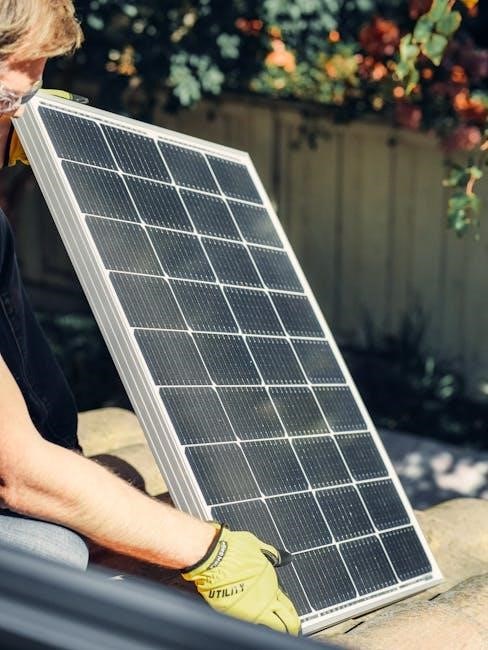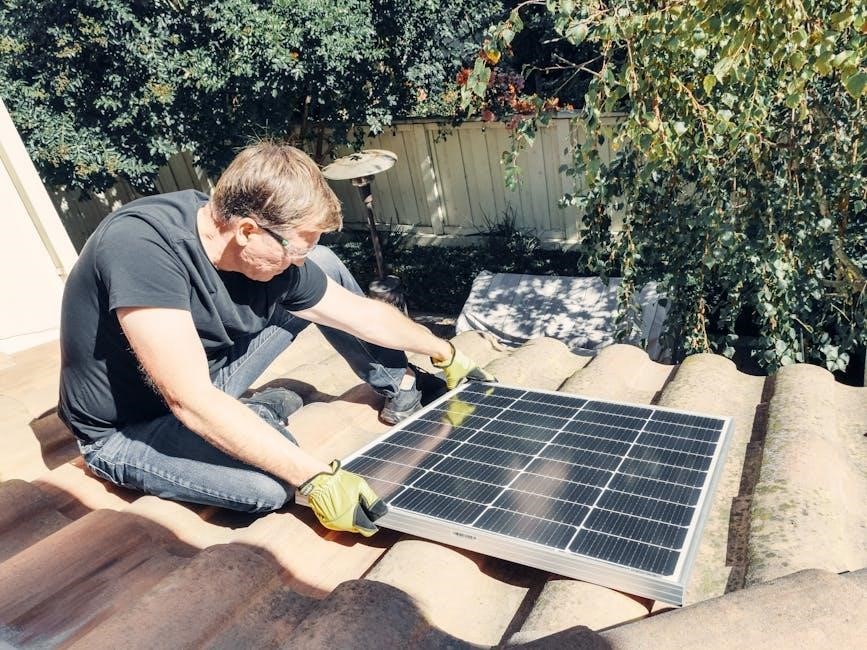Solar energy is a renewable resource harnessing the sun’s power. A solar energy worksheet PDF is an educational tool helping students learn about sustainability and energy efficiency, promoting engagement and understanding of solar power basics.
1.1 What is Solar Energy?
Solar energy is the clean, renewable power derived from the sun’s rays. It is harnessed using photovoltaic cells or solar panels to generate electricity. A solar energy worksheet PDF provides educational resources to explore this topic, offering activities and data collection tools. Solar energy is free, unlimited, and non-polluting, making it a sustainable solution for powering homes, schools, and businesses while promoting energy literacy and environmental stewardship.

1.2 Importance of Solar Energy in Today’s World
Solar energy is vital for sustainability, enhancing resource use and improving quality of life. It supports economic growth and environmental health by reducing reliance on fossil fuels. A solar energy worksheet PDF helps students explore its significance, promoting energy literacy and inspiring actions to mitigate climate change while fostering a cleaner, greener future for generations to come.
Benefits of Solar Energy
Solar energy is a clean, renewable resource with unlimited supply and zero pollution. It supports sustainability, resource efficiency, and economic growth. A solar energy worksheet PDF helps students and educators explore these benefits, promoting energy literacy and environmental stewardship through interactive learning tools.
2.1 Environmental Benefits
Solar energy significantly reduces reliance on fossil fuels, lowering greenhouse gas emissions and combating climate change. It minimizes pollution, preserving air and water quality. A solar energy worksheet PDF educates students about these benefits, highlighting how solar power reduces carbon footprints and promotes a cleaner, sustainable environment. This resource fosters awareness of renewable energy’s role in protecting ecosystems and wildlife, encouraging eco-friendly practices for future generations.
2.2 Economic Benefits
Solar energy offers significant economic benefits, including reduced energy costs and job creation in the renewable energy sector. A solar energy worksheet PDF helps students explore how solar power lowers electricity bills and supports economic growth. By understanding solar energy’s financial advantages, students can appreciate its role in sustainable development and resource efficiency, fostering a deeper connection to eco-friendly practices and career opportunities in the renewable energy field.
2.3 Sustainability and Resource Efficiency
Solar energy promotes sustainability by utilizing a limitless, renewable resource—the sun. A solar energy worksheet PDF educates students on how solar power reduces reliance on finite resources, lowering environmental impact. By exploring resource efficiency, students learn how solar systems optimize energy use, contributing to a sustainable future and fostering eco-conscious practices in energy consumption and management.

How Solar Panels Work
Solar panels convert sunlight into electricity using photovoltaic cells. A solar energy worksheet PDF explains this process, helping students understand how modules capture light energy to generate power efficiently.
3.1 Basic Principles of Photovoltaic (PV) Cells
Photovoltaic cells convert sunlight into electricity through the photovoltaic effect. When sunlight hits a semiconductor material, it frees electrons, creating an electrical current. This process is fundamental to solar energy systems, enabling the conversion of light energy into usable power. Educational resources, like a solar energy worksheet PDF, often include diagrams and explanations to help students grasp this essential concept in renewable energy technology.
3.2 Components of a Solar Panel System
A solar panel system consists of photovoltaic (PV) cells, an inverter, mounting structures, and wiring; PV cells generate electricity when exposed to sunlight. The inverter converts DC power to AC for household use. Mounting structures secure panels, and wiring connects components. A solar energy worksheet PDF often includes diagrams and explanations to help students identify and understand these parts, promoting hands-on learning and energy literacy.
3.3 Energy Conversion Process
Solar panels convert sunlight into electricity through photovoltaic cells. When sunlight hits these cells, electrons are energized, creating a current. The inverter then converts DC power to AC for use in homes or schools. A solar energy worksheet PDF often includes diagrams illustrating this process, helping students visualize how solar energy is harnessed and transformed into usable power, while emphasizing its role in reducing carbon footprints and promoting sustainability.
Solar Energy Educational Resources
A solar energy worksheet PDF offers interactive learning tools, comprehensive guides for educators, and hands-on activities to teach students about renewable energy, sustainability, and solar power basics.
4.1 Solar Energy Worksheets for Students
Solar energy worksheet PDFs provide engaging, hands-on activities for students to explore renewable energy concepts. These resources include exercises on calculating energy output, understanding solar modules, and sustainability. Designed for various grade levels, they align with educational standards, promoting energy literacy. Interactive tasks encourage critical thinking and practical application, making complex topics accessible. Free and downloadable, these worksheets are ideal for classrooms, supporting both teachers and students in learning about solar power and its benefits.
4.2 Comprehensive Guides for Educators
Comprehensive guides for educators provide detailed lesson plans and resources to teach solar energy effectively. These guides include hands-on activities, worksheets, and assessments, aligning with educational standards. They offer insights into solar modules, energy efficiency, and sustainability, supporting a curriculum-focused approach. Designed to enhance teaching, these guides ensure students gain a deep understanding of solar power and its applications, fostering energy literacy and critical thinking skills in the classroom.
4.3 Interactive Tools for Learning
Interactive tools for learning, such as the Renewable Energy Living Lab, enable students to explore solar energy through hands-on activities and data collection. These tools provide simulations and real-world applications, making learning engaging and practical. They allow students to analyze solar module performance, understand energy conversion, and design efficient systems. Such resources bridge theory and practice, fostering deeper comprehension and encouraging students to pursue STEM careers in renewable energy fields.
Solar Energy Activities for Students
A solar energy worksheet PDF offers interactive learning through hands-on experiments and data collection. Students explore solar module performance, energy conversion, and design efficient systems, fostering practical understanding and engagement.

5.1 Hands-On Experiments with Solar Modules
Students engage in hands-on experiments using solar modules to explore energy conversion. They collect data on power output under varying conditions, analyzing efficiency and performance. A solar energy worksheet PDF guides these activities, providing structured exercises for measuring voltage, current, and resistance. These experiments promote energy literacy and encourage students to design innovative solar systems, fostering critical thinking and problem-solving skills while understanding renewable energy principles.
5.2 Renewable Energy Living Lab Activities
Renewable Energy Living Lab activities enable students to interactively explore solar energy concepts. Using a solar energy worksheet PDF, they collect and analyze data on energy output, efficiency, and environmental impact. These labs align with educational goals, fostering hands-on learning and critical thinking. Students investigate how solar modules perform under varying conditions, gaining practical insights into renewable energy systems and their real-world applications, while developing essential STEM skills.
5.3 Data Collection and Analysis Projects
Data collection and analysis projects involve students gathering and interpreting solar energy data. Using a solar energy worksheet PDF, they record metrics like energy output, temperature, and system efficiency. Students analyze patterns, create graphs, and draw conclusions about performance. These projects enhance STEM skills, encouraging critical thinking and problem-solving. By presenting findings, students gain confidence in communicating complex data, fostering a deeper understanding of renewable energy systems and their practical applications.
Lesson Plans for Teaching Solar Energy
Solar energy worksheet PDFs provide structured lesson plans, engaging activities, and hands-on exercises. These resources support educators in teaching solar energy concepts, promoting energy literacy and sustainability awareness effectively.

6.1 Curriculum Alignment and Learning Objectives
Solar energy worksheet PDFs are designed to align with educational standards, focusing on renewable energy and sustainability. These resources support learning objectives by engaging students in activities that promote energy literacy. Worksheets include exercises on solar energy basics, data collection, and analysis, fostering critical thinking and problem-solving skills. They are tailored for various grade levels, ensuring comprehensive understanding and practical application of solar energy concepts in an educational setting.
6.2 Classroom Activities and Discussions
Solar energy worksheet PDFs facilitate engaging classroom activities, such as designing solar panel layouts or conducting experiments with solar modules. These exercises encourage group discussions on renewable energy, sustainability, and energy efficiency. Students analyze data, map sunlight patterns, and explore real-world applications, fostering collaboration and critical thinking. Interactive tools and hands-on tasks promote energy literacy and STEM skills, making complex concepts accessible and fun for learners of all ages.

6.3 Assessment and Evaluation Methods
Educators use solar energy worksheet PDFs to assess student understanding through quizzes, diagrams, and short-answer questions. Performance is evaluated based on accuracy, critical thinking, and problem-solving skills. Group discussions and presentations also serve as assessment tools, allowing teachers to gauge comprehension of solar energy concepts. These methods ensure students meet learning objectives and develop a strong foundation in renewable energy principles, fostering both individual and collaborative learning outcomes effectively.
Technical Aspects of Solar Energy Systems
A solar energy worksheet PDF explains the technical components of solar systems, including photovoltaic cells, inverters, and mounting structures. It also covers factors like temperature and shading that affect efficiency.

7.1 Solar Panel Efficiency and Performance
A solar energy worksheet PDF provides insights into solar panel efficiency, explaining how factors like temperature, shading, and panel orientation impact performance. It highlights the importance of maximizing energy output through optimal installation and maintenance, ensuring students understand the technical aspects of solar systems and their real-world applications in renewable energy solutions.
7.2 Factors Affecting Energy Output
A solar energy worksheet PDF explores factors influencing solar panel energy output, such as temperature, shading, and panel orientation. It explains how seasonal changes and weather conditions impact efficiency, providing students with practical insights to optimize solar systems and maximize renewable energy generation effectively.
7.3 Advanced Technologies in Solar Energy
A solar energy worksheet PDF highlights cutting-edge technologies like bifacial panels and perovskite cells, enhancing efficiency. It also covers energy storage solutions and smart inverters, enabling better grid integration. These innovations address energy output variability, ensuring reliable and sustainable power generation while reducing environmental impact, as detailed in educational resources for students and educators.

Safety Precautions and Best Practices
A solar energy worksheet PDF emphasizes safety guidelines for handling solar panels and equipment. It ensures students and educators follow proper precautions to avoid accidents and injuries during experiments.

8.1 Handling Solar Panels and Equipment
A solar energy worksheet PDF provides essential safety guidelines for handling solar panels and equipment. It emphasizes proper handling techniques, use of protective gear, and safe installation practices. Students learn to avoid electrical hazards and ensure secure connections. The resource also outlines tools needed for setup and maintenance, promoting a safe learning environment for hands-on activities.
8.2 Safety Guidelines for Students and Educators
A solar energy worksheet PDF outlines essential safety guidelines for students and educators. It emphasizes proper handling of solar panels, use of protective gear, and adherence to installation best practices. The resource highlights potential electrical hazards and ensures safe connections. While no specific safety precautions are required for this lesson, following guidelines is crucial to maintain a secure learning environment for all participants.
8.3 Troubleshooting Common Issues
A solar energy worksheet PDF provides guidance on troubleshooting common issues in solar panel systems. It helps identify problems like faulty connections, shading, or inefficient energy conversion. The resource offers step-by-step solutions and encourages students to analyze data for optimal performance. By addressing these challenges, educators and learners can gain practical insights into maintaining and improving solar energy systems effectively.
Solar Energy and the Environment
A solar energy worksheet PDF educates students on reducing carbon footprints and mitigating climate change, promoting sustainable practices and environmental stewardship through interactive learning activities.
9.1 Reducing Carbon Footprint
A solar energy worksheet PDF helps students understand how solar power reduces carbon emissions. By analyzing data and completing activities, learners explore how solar energy minimizes reliance on fossil fuels, lowering greenhouse gases and combating climate change. These educational tools emphasize the role of renewable energy in creating a sustainable future, inspiring students to adopt eco-friendly practices and promote environmental conservation through interactive and engaging methods.
9.2 Impact on Ecosystems and Wildlife
A solar energy worksheet PDF highlights the positive impact of solar power on ecosystems and wildlife. By reducing pollution and greenhouse gas emissions, solar energy helps protect habitats and biodiversity. Educational resources emphasize how renewable energy minimizes environmental damage, preserving natural ecosystems for future generations. These tools encourage students to explore the ecological benefits of solar energy and its role in maintaining a healthy planet.
9.3 Mitigating Climate Change
A solar energy worksheet PDF explains how solar power reduces carbon emissions, a key factor in mitigating climate change. By transitioning to renewable energy, solar systems decrease reliance on fossil fuels, lowering greenhouse gases. Educational resources highlight the role of solar energy in combating global warming, offering practical solutions for sustainable energy use and empowering students to contribute to a cleaner, greener future.

Real-World Applications of Solar Energy
Solar energy’s versatility shines in real-world applications, powering schools, homes, and businesses. Large-scale solar farms generate significant electricity, while solar energy worksheet PDFs educate students on these practical uses.
10.1 Residential and Commercial Use Cases
Solar energy is widely used in homes and businesses to reduce energy costs and carbon emissions. Schools are adopting solar panels to maximize energy output and promote sustainability. Educational resources, such as the solar energy worksheet PDF, provide practical knowledge for students and educators, enhancing understanding of renewable energy systems and their applications in both residential and commercial settings.
10.2 Solar Farms and Large-Scale Projects
Large-scale solar farms generate significant amounts of clean energy, reducing reliance on fossil fuels. These projects supply power to the grid, supporting entire communities. The solar energy worksheet PDF educates students on how solar farms operate, their environmental benefits, and their role in promoting sustainability. Such resources help learners understand the scalability and impact of solar energy in addressing global energy demands and climate change challenges.
10.3 Case Studies and Success Stories
The solar energy worksheet PDF highlights real-world applications and success stories, showcasing communities and schools that have successfully implemented solar projects. These case studies demonstrate the practical benefits of solar energy, such as reduced energy costs and environmental impact. By analyzing these examples, students gain insights into the feasibility and advantages of solar power, inspiring them to explore its potential in their own communities and beyond.
The solar energy worksheet PDF serves as a valuable resource for understanding solar power’s significance. It promotes education, sustainability, and practical applications, inspiring further exploration and learning in renewable energy.
11.1 Summary of Key Points
A solar energy worksheet PDF is an essential educational tool for teaching students about renewable energy. It provides hands-on activities, promoting energy literacy and sustainability awareness. These resources help students understand solar power basics, such as photovoltaic cells and energy efficiency. By engaging with these materials, learners develop critical thinking skills and a deeper appreciation for environmental conservation. The worksheets also align with curriculum goals, making them a valuable asset for educators and students alike in exploring solar energy’s potential.
11.2 Encouraging Future Exploration and Learning
A solar energy worksheet PDF serves as a gateway for students to explore renewable energy further. By engaging with interactive activities, learners develop a deeper understanding of solar power and its applications. These resources align with educational standards, fostering curiosity and a passion for STEM fields. Encouraging hands-on learning, they inspire students to pursue careers in sustainability and innovation, shaping a brighter, greener future for generations to come.
